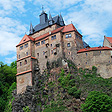MONUMENT TO THE BATTLE OF NATIONS - LEIPZIG
Napoleon's Defeat at The Battle of Leipzig
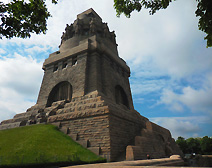 The Battle of Leipzig in 1813 was the beginning of the end for the empire ambitions of Napoleon Bonaparte. For three days from the 16th to the 19th of October 1813, a coalition of armies from Russia, Prussia, Austria and Sweden serving the Russian Czar Alexander I faced off against Napoleon’s Grand Armée combined with troops from Italy, Poland and the Confederation of the Rhine. It was the last of a series of battles called the War of the Sixth Coalition.
The Battle of Leipzig in 1813 was the beginning of the end for the empire ambitions of Napoleon Bonaparte. For three days from the 16th to the 19th of October 1813, a coalition of armies from Russia, Prussia, Austria and Sweden serving the Russian Czar Alexander I faced off against Napoleon’s Grand Armée combined with troops from Italy, Poland and the Confederation of the Rhine. It was the last of a series of battles called the War of the Sixth Coalition.
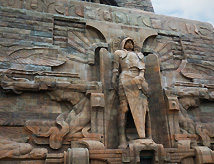 Napoleon had faced defeat for the first time in his attempt to occupy Moscow during the brutal Russian winter of 1812. After reconstituting his decimated army and despite war weariness at home, Napoleon had success at the Battle of Dresden, but moving on the Hohenzollern capital of Berlin, and after a series of other battles he was surrounded on the fields outside the city of Leipzig. With 220,000 troops on Napoleon’s side and 380,000 in the armies of the Sixth Coalition of European nations, the battle was the largest ever in Europe until World War I and the bloodiest battle of the Napoleonic Wars. Napoleon was forced to retreat to France, pursued by the forces of the Russian coalition, wreaking havoc across the French countryside in their wake and moving on Paris, forcing Napoleon to abdicate and return to his first exile on the Island of Elba.
Napoleon had faced defeat for the first time in his attempt to occupy Moscow during the brutal Russian winter of 1812. After reconstituting his decimated army and despite war weariness at home, Napoleon had success at the Battle of Dresden, but moving on the Hohenzollern capital of Berlin, and after a series of other battles he was surrounded on the fields outside the city of Leipzig. With 220,000 troops on Napoleon’s side and 380,000 in the armies of the Sixth Coalition of European nations, the battle was the largest ever in Europe until World War I and the bloodiest battle of the Napoleonic Wars. Napoleon was forced to retreat to France, pursued by the forces of the Russian coalition, wreaking havoc across the French countryside in their wake and moving on Paris, forcing Napoleon to abdicate and return to his first exile on the Island of Elba.
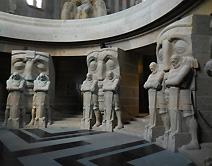 A monument was proposed to be built on the site of the battle in 1814, the year after it took place, but the marker of the would not be built until the 100 year anniversary in 1913, ironically being completed just a few months before the assassination of the Habsburg Archduke Ferdinand struck the match to begin the next Great War. In the monument which was intended to honor the fallen in battle, one can almost feel more the nobility and idealization of war rather than the cost, with the design giving the sense of sleeping Teutonic knights about to awake, rather than mourning.
A monument was proposed to be built on the site of the battle in 1814, the year after it took place, but the marker of the would not be built until the 100 year anniversary in 1913, ironically being completed just a few months before the assassination of the Habsburg Archduke Ferdinand struck the match to begin the next Great War. In the monument which was intended to honor the fallen in battle, one can almost feel more the nobility and idealization of war rather than the cost, with the design giving the sense of sleeping Teutonic knights about to awake, rather than mourning.
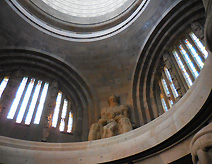 The Monument of the Battle of Nations (Völkerschlachtdenkmal), rising above a long reflecting pool is like a Germanic version of an Egyptian pyramid, built on top of its own artificial mountain, an example of the purest of “Wilhelmine” architecture, that style of particularly heavy construction during periods of the German Kaisers Wilhelm I and II. Built of concrete with facing stones of granite, just under 300 feet tall, with inner chambers and observation decks, it is the tallest war monument in Europe. The work of three architects, first conceived as a National Cathedral by famed German architect Karl Friedrich Schinkel, with funding started by Clemens Thieme, and the final design completed by Bruno Schmitz. The building took fifteen years, 300,000 stones and 6 million German gold Marks to complete.
The Monument of the Battle of Nations (Völkerschlachtdenkmal), rising above a long reflecting pool is like a Germanic version of an Egyptian pyramid, built on top of its own artificial mountain, an example of the purest of “Wilhelmine” architecture, that style of particularly heavy construction during periods of the German Kaisers Wilhelm I and II. Built of concrete with facing stones of granite, just under 300 feet tall, with inner chambers and observation decks, it is the tallest war monument in Europe. The work of three architects, first conceived as a National Cathedral by famed German architect Karl Friedrich Schinkel, with funding started by Clemens Thieme, and the final design completed by Bruno Schmitz. The building took fifteen years, 300,000 stones and 6 million German gold Marks to complete.
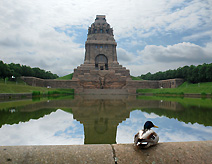 There are over 500 steps to the viewing platform at the top, from which there are spectacular views to the city of Leipzig and surrounding countryside of Saxony. Inside the monument are two stories of Olympian scale statuary, sculpted by Christian Behrens and completed by his apprentice Franz Metzner. On the lower level are eight statues representing fallen soldiers watched over by the Guards of the Dead. On the level above the Hall of Fame, consists of four great statues, each of them 30 feet tall representing the qualities of the German people, bravery, sacrifice, fertility and faith. Part of the distance to the top is by elevator to the levels the crypts with the rest of the way by climbing.
There are over 500 steps to the viewing platform at the top, from which there are spectacular views to the city of Leipzig and surrounding countryside of Saxony. Inside the monument are two stories of Olympian scale statuary, sculpted by Christian Behrens and completed by his apprentice Franz Metzner. On the lower level are eight statues representing fallen soldiers watched over by the Guards of the Dead. On the level above the Hall of Fame, consists of four great statues, each of them 30 feet tall representing the qualities of the German people, bravery, sacrifice, fertility and faith. Part of the distance to the top is by elevator to the levels the crypts with the rest of the way by climbing.
Visiting the Monument of the Battle of Nations
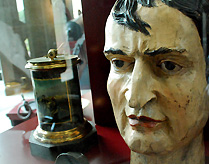 The ticket office and shop is in a fore building originally a construction office to the left of steps to the monument, while to the right is the Forum 1813 Museum. The small modern museum is on two floors, with exhibits dedicated to the Napoleonic Wars and the Battle of Leipzig, with dioramas of the battle, some uniforms, documentation and illustrations for some of the principal figures in the story, paintings and artifacts of the times, and busts of Napoleon. The monument is just to the south of Leipzig, reached by car or Tram 15 from the Leipzig Rail Station. It is open daily from 10 am to 6 pm from April to October and 10 am to 4 pm from November to March. Admission is €6 for adults, €4, students and seniors, free for children under 6 years. Just a little further down the road is the Zum Kaiser Napoleon Restaurant and Beer Garden where Napoleon and the King of Naples sat in the garden in 1813 deciding to withdraw from the battlefield, now a brewery pub. © Bargain
Travel Europe
The ticket office and shop is in a fore building originally a construction office to the left of steps to the monument, while to the right is the Forum 1813 Museum. The small modern museum is on two floors, with exhibits dedicated to the Napoleonic Wars and the Battle of Leipzig, with dioramas of the battle, some uniforms, documentation and illustrations for some of the principal figures in the story, paintings and artifacts of the times, and busts of Napoleon. The monument is just to the south of Leipzig, reached by car or Tram 15 from the Leipzig Rail Station. It is open daily from 10 am to 6 pm from April to October and 10 am to 4 pm from November to March. Admission is €6 for adults, €4, students and seniors, free for children under 6 years. Just a little further down the road is the Zum Kaiser Napoleon Restaurant and Beer Garden where Napoleon and the King of Naples sat in the garden in 1813 deciding to withdraw from the battlefield, now a brewery pub. © Bargain
Travel Europe
Find best hotel and vacation deals in Leipzig on TripAdvisor
Web
Info
Nations Monument
These articles are copyrighted and the sole property of Bargain Travel Europe and WLPV, LLC. and may not be copied or reprinted without permission.
See Also:
YOUNG RICHARD WAGNER - LEIPZIG
AUERBACHS KELLER - GOETHE INSPIRATION LEIPZIG
COLDITZ CASTLE WWII POW ESCAPES

